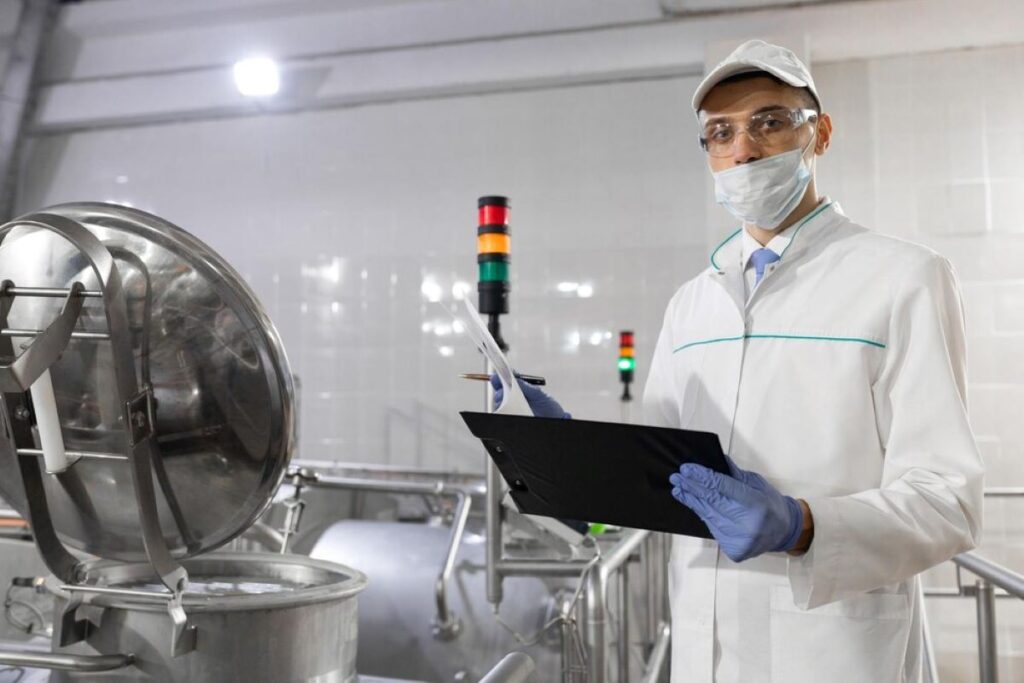The Role of Food Safety Compliance Software in HACCP Readiness

Food safety is crucial in today’s food industry, and Hazard Analysis and Critical Control Points (HACCP) is the gold standard for ensuring safe food production and handling. This systematic approach identifies, evaluates, and controls potential food safety hazards throughout the production process.
Digital transformation has changed the game for HACCP implementation with the introduction of specialised food safety compliance software. These advanced solutions make the complex requirements of HACCP systems easier to manage by offering:
- Real-time monitoring capabilities
- Automated documentation processes
- Instant alert mechanisms for safety violations
- Comprehensive data analysis tools
Food safety compliance software takes traditional HACCP practices and makes them more flexible and responsive. By automating critical monitoring tasks and keeping detailed digital records, these platforms help organisations:
- Reduce human error
- Enhance compliance accuracy
- Improve response times to potential hazards
- Maintain consistent safety standards
The integration of compliance software into HACCP systems is a major step forward in food safety management. It gives organisations the tools they need to protect public health while efficiently and effectively meeting regulatory requirements.
Understanding Hazard Analysis and Critical Control Points (HACCP)
HACCP represents a systematic approach to food safety management through seven essential principles:
- Hazard Analysis: Identification of biological, chemical, and physical hazards
- Critical Control Points: Determination of points where control measures are crucial
- Critical Limits: Establishment of safety parameters for each CCP
- Monitoring Procedures: Implementation of scheduled measurements
- Corrective Actions: Development of specific responses to deviations
- Verification: Confirmation that the system works effectively
- Documentation: Maintenance of accurate records
Conducting a Thorough Hazard Analysis
A thorough hazard analysis examines each step of the food production process, from raw material reception to final product distribution. This analysis identifies potential risks such as:
- Bacterial contamination in raw ingredients
- Chemical residues from cleaning agents
- Physical hazards like metal fragments or glass
- Temperature control failures during storage
- Cross-contamination during handling
Identifying Critical Control Points (CCPs)
Critical Control Points (CCPs) serve as specific locations, steps, or procedures where control measures prevent, eliminate, or reduce food safety hazards to acceptable levels. Examples include:
“A cooking step must reach 75°C for 30 seconds to eliminate harmful bacteria”
The identification of CCPs requires:
- Scientific validation of control measures
- Measurable parameters for monitoring
- Clear documentation of control procedures
- Regular staff training and competency assessment
These control points create a robust safety net throughout the production process, ensuring hazards are managed effectively at crucial stages. Each CCP requires specific monitoring procedures and predetermined corrective actions to maintain food safety standards.
Food safety compliance software is revolutionizing the implementation of HACCP (Hazard Analysis and Critical Control Points). By leveraging automated processes, it simplifies plan development and maintenance. This shift from traditional paper-based systems to digital solutions transforms these methods into efficient platforms for real-time monitoring, thereby enhancing food safety management.
1. Automated Plan Development
Creating an HACCP plan has become significantly easier and faster with food safety compliance software. Automation aids in several ways:
- Digital templates and pre-configured workflows guide users through the process of creating an HACCP plan.
- Smart algorithms use industry-specific data to identify potential hazards.
- Validation checks are performed automatically to ensure all documentation is complete and accurate.
- Built-in approval workflows expedite the review and implementation of plans.
2. Regulatory Compliance Management
Keeping abreast with regulations can be a daunting task, but compliance software streamlines this process. Here’s how:
- Users receive real-time updates on any changes made to FDA (Food and Drug Administration) and USDA (United States Department of Agriculture) regulations, including those outlined in the current title 21 chapter I subchapter B part 117.
- The software performs automated checks to ensure current regulatory requirements are being met.
- Digital documentation trails are created that meet regulatory standards.
- Reports generated by the system adhere to standardised formats accepted by regulatory bodies.
3. Real-Time Monitoring and Analysis
Monitoring critical control points (CCPs) is essential for maintaining food safety. Compliance software provides features that enable effective monitoring:
- Digital sensors continuously track CCPs, providing accurate and reliable data.
- Instant alerts are dispatched when any parameters exceed established limits, allowing for immediate corrective action.
- Automated data collection processes eliminate manual recording errors.
- Historical data analysis aids in identifying trends and assessing risks associated with food safety.
The integration of compliance software creates a robust system for maintaining HACCP standards. Digital platforms like Squizify offer customizable solutions that adapt to specific operational needs while ensuring consistent regulatory compliance. These systems empower food service operations to:
- Track multiple CCPs simultaneously
- Generate automated compliance reports
- Maintain accurate temperature monitoring records
- Access data remotely through secure cloud-based storage
- Implement immediate corrective actions when deviations occur
Advanced analytics capabilities within these platforms provide deeper insights into food safety patterns and potential risks, enabling proactive hazard prevention rather than reactive responses to issues. Check out more about What Is Food Safety Compliance and Why Does It Matter?

Advanced Features of Compliance Software for HACCP Readiness
Modern food safety compliance software incorporates sophisticated features designed to elevate HACCP readiness to new heights. These advanced capabilities transform traditional food safety management into a dynamic, responsive system.
ISO Standards Integration
Food safety compliance platforms align seamlessly with ISO 22000 standards through:
- Digital workflow templates pre-configured to ISO requirements
- Automated documentation management systems
- Standardised reporting mechanisms
- Built-in compliance verification tools
Real-Time Monitoring Capabilities
Advanced monitoring features provide instant visibility into Critical Control Points:
- Continuous temperature monitoring through wireless sensors
- Automated data collection from processing equipment
- Live tracking of hygiene and sanitation procedures
- Digital verification of staff compliance activities
Smart Deviation Alert System
The software’s intelligent alert mechanisms serve as an early warning system:
- Instant notifications when parameters exceed established limits
- Automated escalation protocols for critical violations
- Mobile alerts to designated personnel
- Historical deviation tracking for trend analysis
These advanced features create a robust framework for maintaining HACCP compliance. The integration of smart sensors with automated monitoring systems eliminates manual tracking errors. Digital workflows streamline operations while ensuring adherence to established food safety protocols.
The software’s ability to detect and alert stakeholders about potential hazards in real-time transforms reactive food safety management into a proactive system. This technological advancement enables food businesses to address potential issues before they escalate into significant food safety risks.
Benefits of Compliance Software Integration
Food safety compliance software delivers substantial advantages for organisations seeking to maintain rigorous HACCP standards. The implementation of digital solutions transforms traditional food safety management into a streamlined, efficient process with measurable benefits.
1. Enhanced Audit Readiness
Compliance software enhances an organisation’s preparedness for audits through various features:
- Digital documentation trails provide instant access to historical records
- Time-stamped entries create verifiable proof of compliance activities
- Automated record-keeping eliminates paper-based filing systems
- Real-time data accessibility speeds up audit processes
2. Risk Reduction Through Systematic Monitoring
The integration of compliance software significantly minimises food safety risks through:
- Automated temperature monitoring systems
- Regular equipment calibration tracking
- Systematic allergen control documentation
- Standardised cleaning and sanitisation records
These systematic controls help prevent foodborne illness outbreaks by maintaining consistent monitoring throughout the production cycle. Digital systems ensure no critical checkpoints are missed, creating a robust defence against potential hazards.
3. Demonstrated Commitment to Food Safety
Modern consumers and regulatory bodies expect transparent food safety practices. Compliance software helps organisations:
- Generate detailed reports on demand
- Track and document corrective actions
- Maintain comprehensive supplier verification records
- Create transparent communication channels with stakeholders
The implementation of advanced compliance software sends a clear message about an organisation’s dedication to food safety excellence. This commitment resonates with quality-conscious consumers and strengthens relationships with regulatory authorities.
Digital solutions like Squizify’s platform enable organisations to maintain 24/7 visibility of their food safety operations, creating a robust foundation for continuous improvement and regulatory compliance. The system’s ability to generate instant reports and maintain accurate records positions businesses to respond effectively to both routine inspections and unexpected audits.
Maintaining Continuous Readiness with Compliance Software
A strong food safety culture relies on regular monitoring and proactive risk management. Modern compliance software tools enable organisations to establish robust safety protocols through:
- Real-time monitoring dashboards that display critical safety metrics
- Automated alert systems for immediate notification of potential risks
- Digital checklists that standardise safety procedures across all operations
The implementation of prompt corrective actions becomes seamless with integrated compliance solutions. When things go wrong, the software:
- Triggers immediate notifications to responsible personnel
- Provides step-by-step guidance for remedial actions
- Documents all corrective measures taken
- Tracks the effectiveness of implemented solutions
The Importance of Accurate Documentation in HACCP Compliance
Documentation accuracy is crucial for HACCP compliance. It ensures that all safety procedures are properly recorded and can be easily accessed during audits or inspections.
Digital solutions offer a way to overcome common challenges associated with manual record-keeping:
“Human error in documentation can lead to serious compliance issues and food safety risks. Automated systems reduce these errors by up to 95%.”
With automated systems in place, organisations can significantly reduce the risk of errors in their documentation process.
Enhancing Traceability with Advanced Features
Advanced traceability features are another key benefit of compliance software. These features allow organisations to track ingredients throughout the supply chain, ensuring transparency and accountability at every stage.
Some of the specific ways in which compliance software enhances traceability include:
- Precise tracking: Organisations can accurately monitor the movement of ingredients from suppliers to production facilities and ultimately to customers.
- Automated time stamps: All safety-related activities, such as inspections or temperature checks, are automatically recorded with time stamps for reference.
- Digital signatures: Accountability is reinforced through the use of digital signatures, which verify that specific individuals have completed certain tasks.
- Secure data storage: All documentation related to food safety activities is securely stored in a digital format, making it easy to retrieve when needed.

Strengthening Audit Preparedness with Systematic Documentation
The ability to capture and store accurate information through compliance software creates a comprehensive digital trail of all food safety activities. This systematic approach to documentation strengthens an organisation’s position during audits and inspections.
By having well-organised records readily available, organisations can demonstrate their commitment to food safety and regulatory compliance. This not only helps build trust with auditors but also instills confidence in customers regarding the quality and safety of their products.
Maintaining continuous readiness for HACCP compliance is essential for organisations operating in the food industry. With integrated compliance solutions like those offered by FoodDocs, businesses can streamline their processes, minimise risks, and ensure ongoing adherence to food safety standards.
Moreover, embracing the new era of smarter food safety through advanced technology can further enhance these efforts. Such advancements not only facilitate better monitoring and management but also contribute significantly towards building a stronger food safety culture within the organisation. Implementing best practices in food safety can lead to substantial improvements in overall operational efficiency and risk mitigation.
Conclusion
Food safety compliance software is essential for implementing HACCP effectively. By using digital solutions, food safety management becomes simpler and more efficient.
Organisations that embrace these technological advancements position themselves at the forefront of food safety excellence. Digital compliance tools create:
- Robust documentation systems
- Real-time monitoring capabilities
- Automated alert mechanisms
- Comprehensive audit trails
The implementation of food safety compliance software shows a commitment beyond just following regulations. This dedication to safety resonates with consumers, building trust and strengthening brand reputation in an increasingly quality-conscious market.
A strong food safety culture, supported by advanced compliance software, protects both public health and business interests. The future of food safety management lies in these digital solutions, offering organisations the tools needed to maintain the highest standards of food safety while adapting to evolving industry demands.



